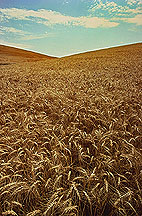|

Ripening wheat on
the Palouse hills of Washington. Click the image for more information about
it.
|
Optical Sensors Help Farmers Find High-Quality
Wheat
By David
Elstein December 17, 2004
Since buyers will pay a premium for high-quality wheat, farmers need
to not only grow it, but also know which exact locations in their fields have
the wheat that buyers desire. Over the past decade, an Agricultural Research
Service (ARS) agronomist in Pendleton,
Ore., has been testing various instruments that may one day help farmers
quickly pinpoint the precise location of high-quality wheat.
Dan
Long started testing wheat-quality measuring devices while teaching at
Montana State University, and he has
continued that work at the ARS
Columbia
Plateau Conservation Research Center in Pendleton. He is currently working
with two firms to develop and test spectroscopic devices that use fiber optics
and near-infrared light to measuring protein concentration of grain. Attached
to a combine, the device measures the protein content of wheat during the
harvesting operation.
Buyers want specific levels of protein, depending on how the wheat
will be used. Bakers need high-protein wheat for making bread, but low-protein
wheat is preferred for cakes, cookies and crackers.
In addition to protein, the optical sensors can measure fat, oil,
carbohydrate and moisture levels in grain. By knowing this information, farmers
may one day be able to segregate grain during harvest and transfer operations,
based on the grain's specific qualities. As with many other crops, a single
field of wheat can produce grain with significant variations in quantity and
quality.
Farmers can also use the sensor-derived information for fertilizer
management, since soil nitrogen and protein levels are correlated. They will be
able to tell which sections of the farm already have enough nitrogen. This
information will help them save money on unnecessary fertilizer applications
and also help protect the environment against surplus nitrogen.
Long will continue testing for grain quality next year and also hopes
to use information from the optical sensors to study crop residue levels. The
sensors probably will not be commercially available for another year or two,
according to Long.
ARS is the U.S. Department of
Agriculture's chief scientific research agency.